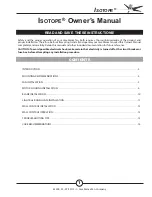
OMM-14-0509-page 6
b. Manual: These motors will have a button on them. If the motor overheats, it will shut down. After you have
inspected the motor and eliminated the over heating problem, you will need to “reset” it by pushing the button.
You should still lock out the power BEFORE inspecting the motor.
c. Thermostats: This type of thermal is a temperature sensing device ONLY. If the motor overheats, the thermo-
stats will open or close (depending on the type) and send a
“signal” to the electrical box.
THEY WILL NOT
TURN THE MOTOR OFF.
These are pilot circuit devices that must be connected to the magnetic starter
circuit.
7. EXPLOSION PROOF Motors: No motor is explosion proof. Explosion proof (EXP) motors are designed so if there is
an explosion
WITHIN the motor, the explosion will be CONTAINED INSIDE the motor and not allowed to get out to
the atmosphere. All explosion proof motors must be selected based on the atmosphere and/or the environment the
motor will be operating in. Explosion proof motors are designed, rated, and labeled for their operating conditions
based on Classes, Groups and “T” Codes.
The Class, Group and “T” Code of an EXP motor MUST be selected
based on the atmosphere and/or environmental conditions the motor will be operating in. Consult the NEC
(National Electric Code) and the NFPA (National Fire Protection Association) for the proper EXP motor
Class, Group and “T” Code required for your specific application and location.
NOTICE:
a. All EXP motors have some type of thermal overload as required by UL (Underwriters Laboratories).
Refer to all of Section 6 on page 5 and above.
b. All EXP motors are required to have the UL (Underwriters Laboratories) and CSA (Canadian Standards
Association) listing numbers on the motor name plate or on a separate plate attached to the motor. The
Class, Group and “T” Code the motor is designed for must also be listed.
8. Normal Motor Operating Temperatures:
Using your hand to test the normal running temperature of a motor can be a very painful experience;
The normal operating temperature of a fully loaded, open type, electric motor operating in a 70°F. (21° C.)
ambient temperature is 174°F. (79° C.)
C. Maximum Fan Speed and Motor Speed Controllers:
If you will be using any type of motor speed controller with this fan,
DO NOT exceed the maximum safe fan speed.
Installing and using a speed control device requires special training and certification as required by the speed con-
trol manufacturer. See the manufacturers instructions for proper use, installation and wiring connections for the maxi-
mum speed settings. It may also be necessary to “block out” some speeds to eliminate a resonant vibration problem.
The maximum safe fan speed is shown on the data sheet shipped with the fan. If you have lost the data sheet, con-
tact Cincinnati Fan or our sales office for your area. You must have the serial number from the
fan name plate for us
to determine the maximum safe fan speed. Cincinnati Fan will only extend the motor manufacturers warranty, when
used with a speed controlling device, if the motor has the words
“Inverter Duty” marked on the motor name plate. If
the motor does not have
“Inverter Duty” marked on the motor name plate, and you have a motor failure, you will be
required to contact the motor manufacturer for any service or warranty claims.
IF AN EXPLOSION PROOF MOTOR IS USED IN AN AREA CONTAINING VOLATILE LIQUIDS, GASES,
FUMES OR DUST FOR WHICH THE MOTOR WAS NOT DESIGNED TO OPERATE IN, AN
EXPLOSION AND/OR FIRE CAN OCCUR.
DANGER
MAKE SURE YOU LOCK OUT THE POWER TO THE MOTOR BEFORE INSPECTING ANY MOTOR WITH
AUTOMATIC THERMALS. WHEN THE THERMALS COOL DOWN, THEY WILL ALLOW THE MOTOR TO
AUTOMATICALLY START UP AGAIN, UNLESS YOU HAVE LOCKED OUT THE POWER TO THE MOTOR.
DANGER






























